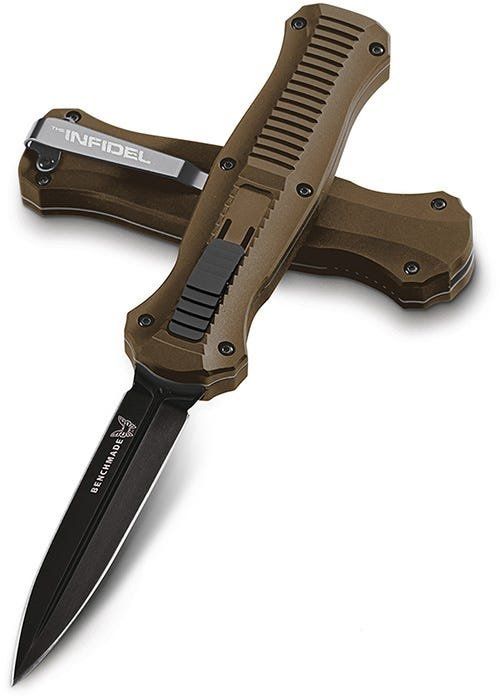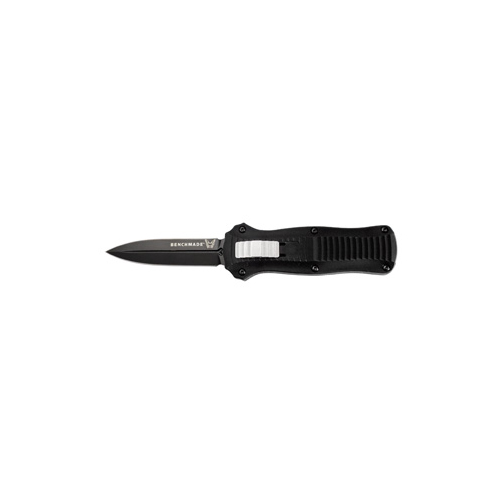
Reattach the handle together and try the mechanism a few times to ensure the blade is in good working order again.Ī dull blade comes with normal use over time.
#BENCHMADE OTF AUTOMATIC KNIVES HOW TO#
Follow the instructions for your specific OTF knife on how to reattach the new spring to the mechanism. You can order a replacement spring from the manufacturer or you can send it back to the manufacturer for them to service. If it's over-stretched or broken in the middle, it needs to be replaced. Use a little bit of lubricant and ensure it reaches all the nooks and crannies inside the knife, wiping out the excess oil before reassembling. Use a lint-free cloth to clean inside the knife thoroughly and wipe down with a cleaning solution if desired. Pull the sides of the handle apart and remove the knife, slide and springs. You will need a 2 mm standard bit and a 5/64th Allen wrench or a tri-wing screwdriver head to remove the screws from the handle. If none of the above solutions work, it's time to look at the springs. Use compressed air to dry the internal components and lubricate the inside mechanism. The solution should flush straight through you may have to repeat this process several times. If this doesn't work, try flushing out your knife with a cleaning solution by removing the glass breaker from the end of the knife. Move the blade in and out several times to work the oil down into the mechanism and springs. Use a light lubricant, like a gun or knife oil which includes rust preventative, and put a few drops on the bottom of the blade where it meets the handle. To remove junk that can build up in the mechanism and springs, lubrication is one of the first easy solutions you can try. If the blade remains fixed, there is usually something jamming the mechanism. If the blade is loose, there is likely something broken in the mechanism. If the blade is sticking, sluggish or completely stuck, then there may be issues inside the mechanism that need to be addressed. If you’ve never cleaned your knife before, you may want to do some research on This will eject it from the mechanism so that you can open up the knife to clean it.

In fact, if you're going to clean your knife, you should deploy it against an inanimate object, like a pad of paper, so it comes off the track. This reset should fix the problem.Ĭheck Out All of Microtech’s Knives We Have Available Slide the mechanism lock back and forth a few times to make sure it stays back on track. If the blade has come off its track in this way, carefully pull the blade out all the way, and it should lock back into place. Usually, it will poke the object and then bounce back halfway into the blade slot.
#BENCHMADE OTF AUTOMATIC KNIVES MOVIE#
Contrary to some popular movie depictions, the spring doesn't have enough power to shoot the blade out and pierce through bone. Sometimes this occurs when the blade is struck against something that doesn't move and it bounces back.


The most common problem with OTF automatic knives is the blade gets stuck and doesn't spring out or draw back in. First, you should try some of these home solutions.

In a worst-case scenario, as long as you haven't abused the knife, you can send it back to the manufacturer for repair. With proper maintenance, you may be able to fix your OTF knife on your own. It may also fall victim to dirt and grime that enters through the blade slot and gets stuck in the springs, causing them to lock up. OTF automatic knives are unique in their design because their springing mechanism is susceptible to weakening over time. Other problems affect most knives with extended use and, luckily, there are easy ways to fix these issues. However, as with any tool, there can be problems that arise in the mechanisms that allow the knife to spring out and pull back over time. Out-the-front knives, or OTF knives, are a popular choice for their reliability, durability and convenience of carry.


 0 kommentar(er)
0 kommentar(er)
